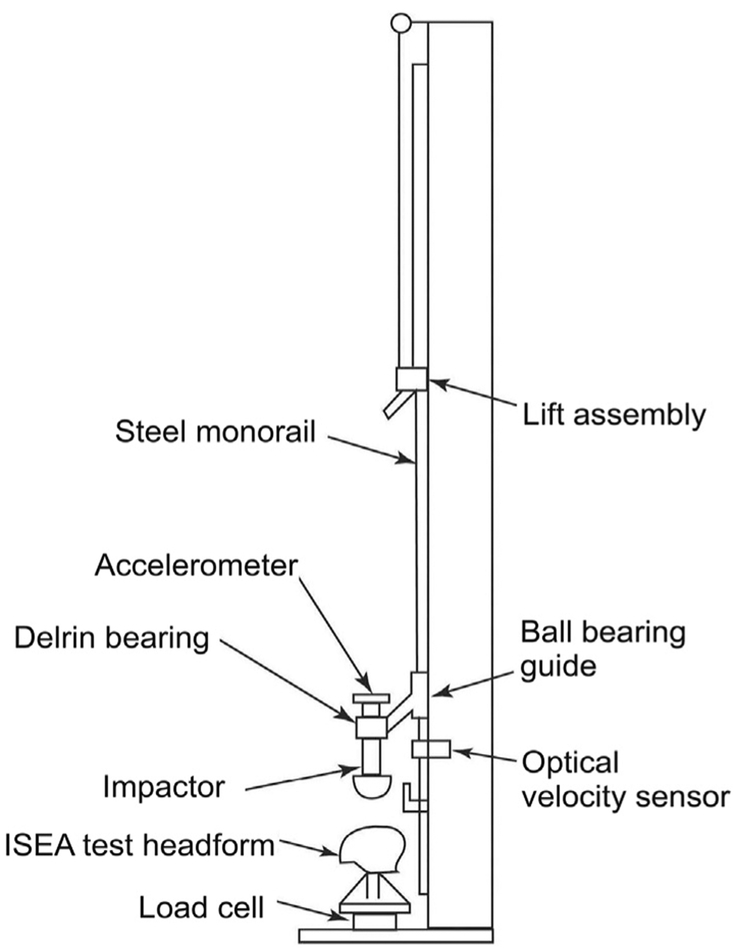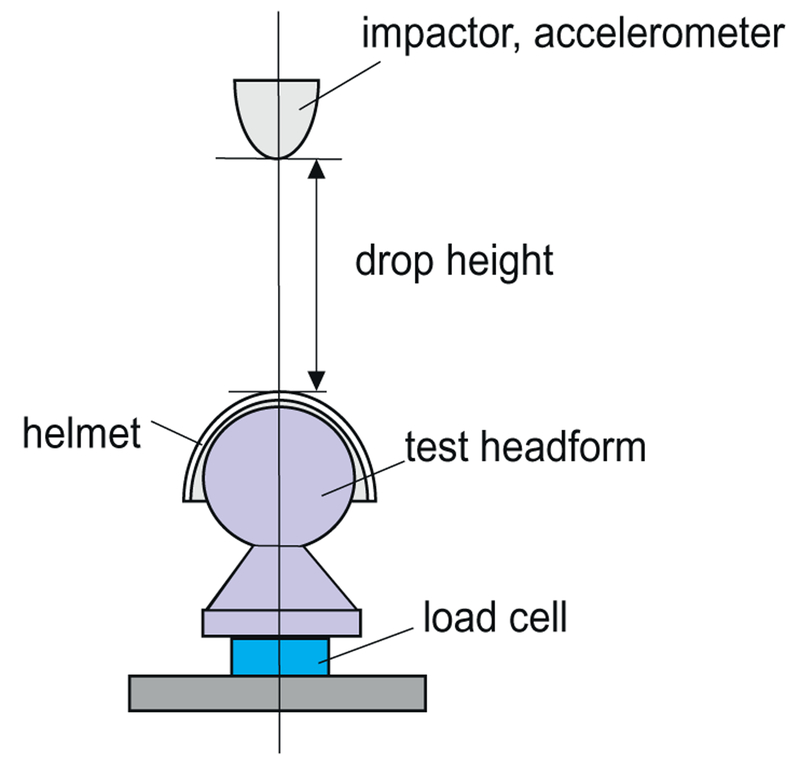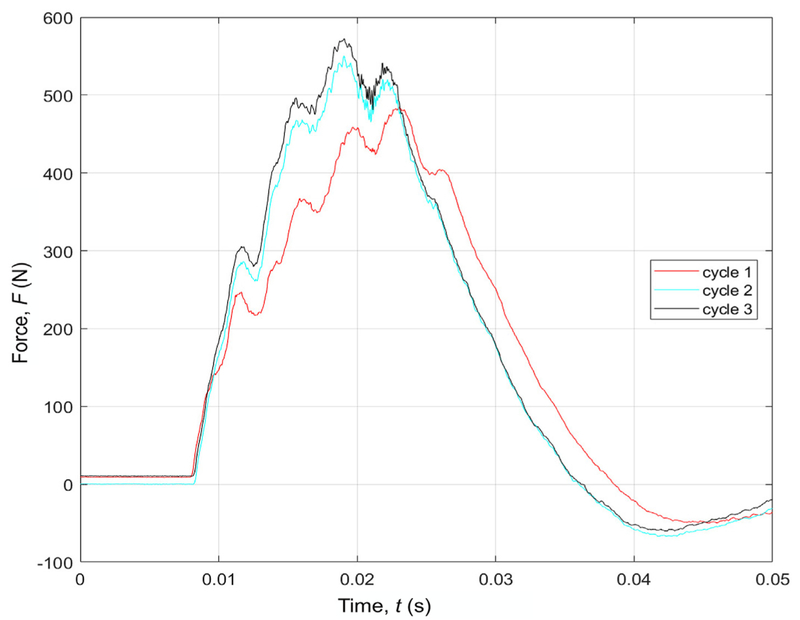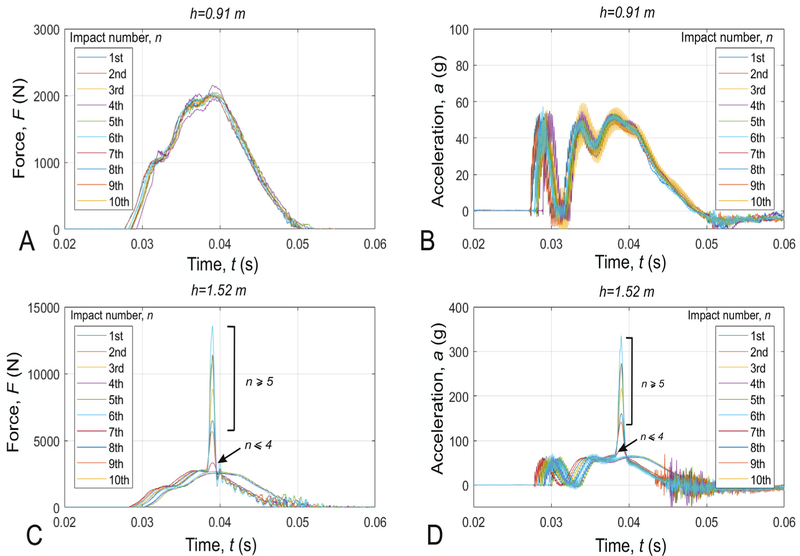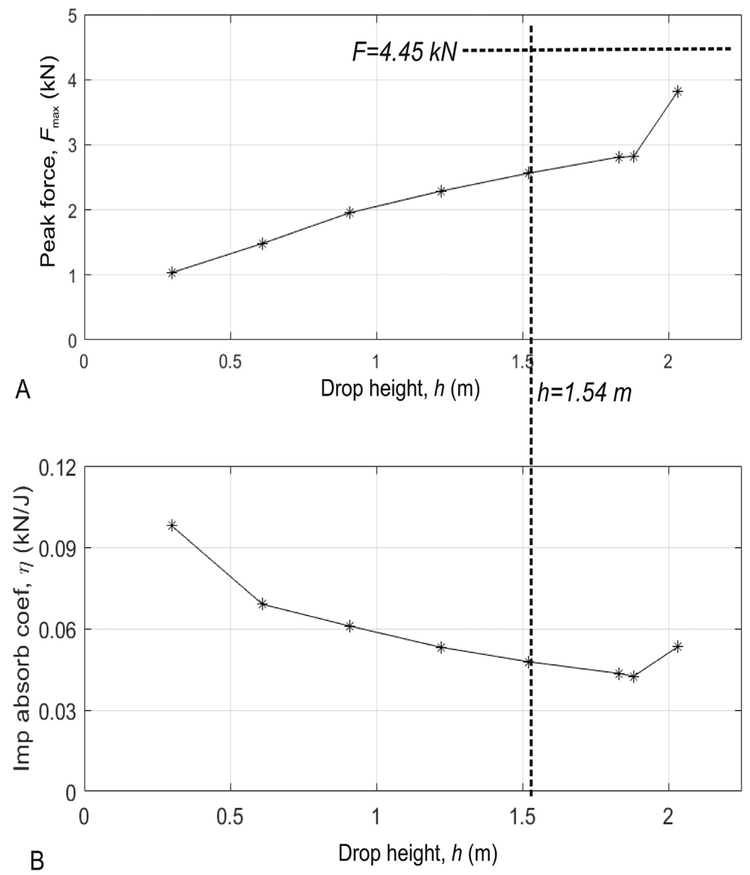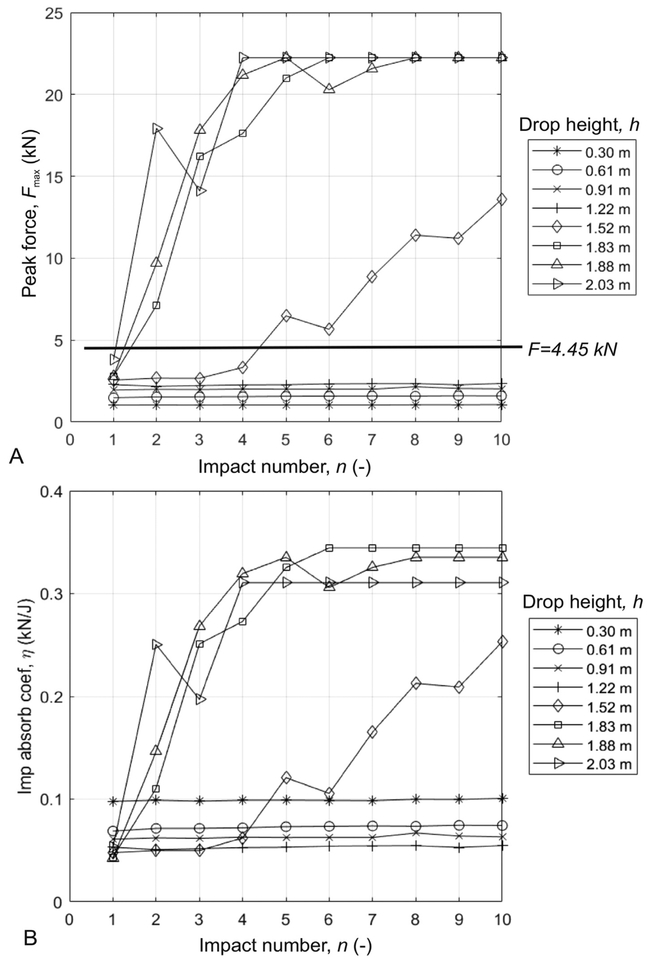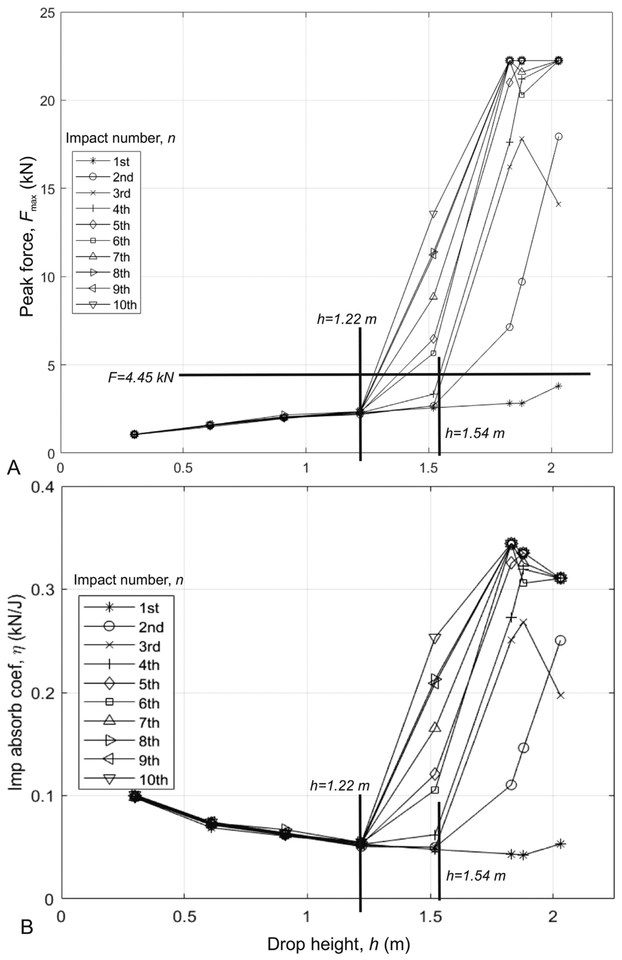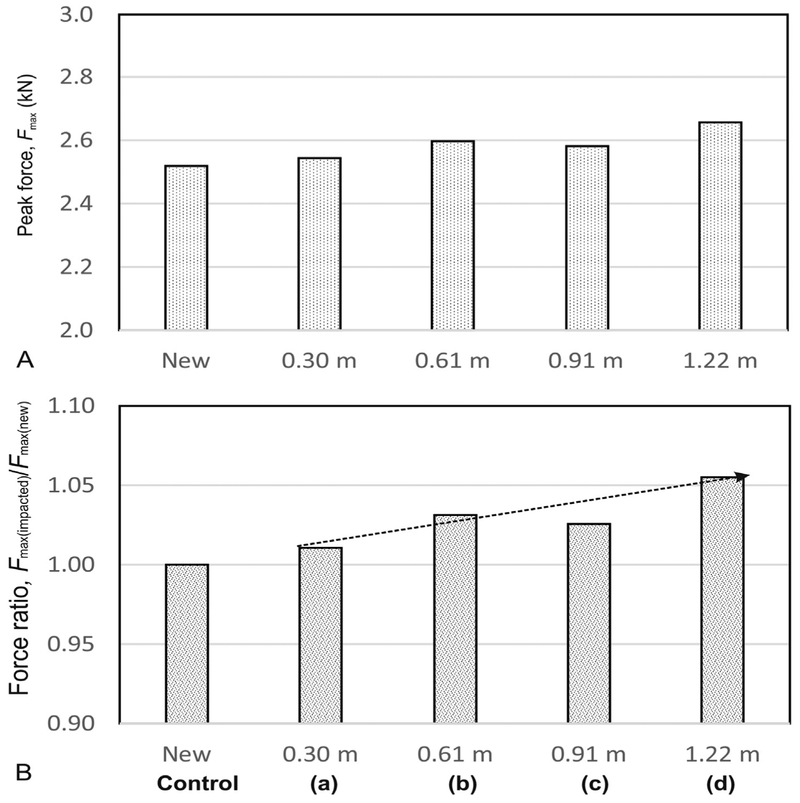Abstract
It is accepted in industries that an industrial helmet should be disposed of when it is subjected to a significant impact. There is no scientific evidence that supports this well-accepted belief. The current study was intended to evaluate the shock absorption performance of industrial helmets under repeated impacts. Common industrial or construction helmets are categorized as Type I according to ANSI Z89.1 and they are designed to mainly protect top impacts. A representative basic Type I construction helmet model was selected in the study. Helmets were repeatedly impacted ten times using a commercial drop tower tester with an impactor (mass 3.6 kg) at different drop heights from 0.30 to 2.03 m. A total of 80 impact trials were performed in the study. The relationships of the transmitted force with the drop height and with impact number were analyzed. A new parameter – the endurance limit – was proposed to evaluate the shock absorption performance of a helmet. The helmets were observed to experience cumulative structural damage with increasing impact number, resulting in a degrading shock absorption performance, when being impacted repeatedly with magnitudes greater than the endurance limit. Repeated impacts with magnitudes smaller than the endurance limit did not cause measurable cumulative structural damage to the helmets in our study.
Keywords: Construction helmet, Experiment, Shock absorption, Top strike, Repeated impacts
1. Introduction
It is well recognized that traumatic brain injury (TBI) is a leading cause of death and disability among persons in North America [1]. Approximately 7.3% of TBI cases identified from the Ontario Trauma Registry were work-related [2]. Based on a review of coroners’ records, about half of all workplace fatalities in Ontario were associated with TBI [3]. Work-related traumatic brain injury (WrTBI) accounted for approximately 20% of traumatic occupational injuries and 60% of work-related deaths in Washington State [4]. WrTBIs have been identified as one of the most serious workplace injuries among all work-related injuries in the United States from 1998 to 2007 [5]. Most of WrTBI cases occurred in the construction industry [6,7]. Streets construction and heavy construction trades have been identified as at the greatest risk for occupational fatalities due to impact-related head injuries [8]. Compared with other types of injuries, WrTBIs are much more likely to result in disability and death [9]. Industrial or construction workers who were wearing safety helmets at the time of a fall were less likely to sustain intracranial injury compared with workers not wearing a safety helmet [2]. The use of helmets was considered as one of the important prevention strategies in constructions [8]. Occupational Safety and Health Administration (OSHA) regulations for the construction industry require that employers shall ensure each employee wears a protective helmet when working in areas where there is a potential for injury to the head from falling objects [10]. Since the shock performance is the most important parameter for a helmet, there are strict regulations for the impact tests in different international standards [11–13]. However, it is not required in any standards to test a helmet with repeated impacts. The shock absorption performance of industrial helmet under repeated impacts has not been analyzed.
Repeated head impacts are common in many sports activities. For example, football players on average receive 6.3 head impacts per practice and as many as 14.3 head impacts per game [14]. The number of head impacts over the course of a season can reach as high as 1400 [14]. Since it is not practical to replace a helmet after a head impact in many sports, researchers investigated the shock absorption performance of different sports helmets. Tomioka et al. [15] performed repeated impact tests to study the effects of the impact number on the performance of baseball helmets using an impact ball and a head model. They found that the acceleration transmitted to the head model increased remarkably after the helmet received a large impact, which caused damage to the helmet’s liner materials. Mattacola et al. [16] tested equestrian helmets to evaluate the impact absorbing ability after multiple impacts to the crown. Their results indicated that the equine helmets are incapable of meeting ASTM F1163 standard [17] after two impacts; and they suggest that equine helmets should be replaced after an initial impact. Pearsall and Hakim-Zadeh [18] tested the impact attenuation properties of five different hockey helmet models. They also observed gradual decreases in impact attenuation properties(i.e. increase in peak acceleration transmitted to the head model), with increasing repeated impacts; and the degrading in performance varied with helmet model due to the differences in the liner padding materials, shapes, thickness, and outer shell geometry. Cournoyer et al. [19] performed repeated impact tests on American football helmets using a drop rig certified by the National Operating Committee on Standards for Athletic Equipment (NOCSAE). They observed that American football helmets demonstrated a measurable decrease in the capacity to attenuate linear acceleration after 100 impacts. However, even after multiple impacts, the helmets’ shock absorption performance was still within well-acceptable levels, and the helmets still maintained their protective capacity against head injuries. Lam and Gates [20] performed repeated drop impacts of a DOT-approved motorcycle helmet using a drop tower system in accordance with Federal Motor Vehicle Safety Standard (FMVSS) 218 [21]. They observed the degradation of the protective ability of the helmets after a significant impact; however, the helmets still retained some protective capability even after ten impacts. Swaren et al. [22] studied the shock-attenuation performance of Alpine ski helmets using two different liner materials, i.e., expanded polystyrene (EPS) and expanded polypropylene (EPP). To our best knowledge, no study has been performed to investigate the shock absorption performance of industrial helmets under repeated impacts.
Although it is not regulated by OSHA or in test standards, helmet manufacturers (e.g., 3 M Occupational Health and Environmental Safety [23], MSA Safety [24], Columbia Safety and Supply [25], and ED Bullard Co [26]) recommend the replacement of industrial helmets immediately after a significant impact. However, there is no direct scientific evidence in the literature to support this generally-accepted rule. Although there are some studies on the performance of sports helmets in repeated impacts, the helmets used in sports are different from industrial helmets in structure and material. The knowledge obtained in the studies involving sports helmets cannot be directly transferred to industrial helmets. The purposes of the current study were to evaluate the shock absorption performance of industrial helmets under repeated impacts and to verify if it is safe to reuse a helmet that has been subjected to an impact. The knowledge obtained in our study would be essential to improve the current safety management in industries. Industrial or construction helmets are categorized as Type I and Type II [11–13]. Type I helmets are designed to mainly protect top impacts and they are commonly used in industries. A representative basic Type I construction helmet model was selected in the study. Our hypotheses were that the performance of shock absorption of an industrial helmet will be compromised after a large impact and that impacts of small magnitude will not cause structural damage resulting in the degradation of shock absorption performance.
2. Method
2.1. Experimental setup
Helmet impact tests were performed according to the Type I impact protocol in ANSI Z89.1 standard (ANSI/ISEA Z89.1, 2014): the free-fall impactor impacts onto the fixed helmet [27]. The Type I helmet is designed to protect top impact by a drop object. A commercial drop tower test machine (H.P. White Laboratory, Street, MD, USA), as illustrated in Figs.1 and 2, was used in the tests. The impactor, which is of aluminum and has a mass of 3.6 kg, is raised to a predetermined height and dropped freely in a guided rail; and it impacts onto the helmet at the top crown. The helmet is fixed on a headform, which is of aluminum and has a mass of 3.64 kg. A force sensor (Model 925M113, Kistler, Amherst, NY, USA) installed at the base of the headform was used to measure the forces transmitted to the headform, and an accelerometer (Model 357B03, PCB Electronics, Depew, NY, USA) installed within the impactor was used to measure the acceleration of the impactor during impacts (Fig. 2). Both force and acceleration data were collected at a sampling rate of 25 kHz.
Fig. 1.
Drop tower test machine. The drop tower consists of a pedestal, a headform, linear bearing rail, drop carriage, drop impactor, and lift mechanism.
Fig. 2.
Schematic of test procedure. The control parameter was the drop height; the acceleration of the impactor and transmitted force at the base of the headform were measured.
2.2. Test procedure and data processing
A typical, basic construction helmet model, which is categorized as Type I helmet according to ANSI Z89.1, was used in the current study. The impact tests were performed at eight drop heights: 0.30, 0.61, 0.91, 1.22, 1.52, 1.83, 1.88, and 2.03 m. Assuming a free fall condition for the impactor, the impact velocity is related to the drop height by , with g and h being the gravitational acceleration and the drop height, respectively. The drop heights from 0.30 m (1.00 ft) to 2.03 m (6.67 ft), as tested in the current study, were estimated to result in impact velocities from 2.4 m/s to 6.3 m/s. The selected range of the drop heights was relevant to the test standard ANSI Z89.1. In ANSI Z89.1, the drop impactor reaches a velocity of 5.5 m/s just before impact, which is equivalent to a drop height of 1.54 m. In the tests, the drop height was varied from “low” to “high”, compared to the reference value of 1.54 m, with an increment of approximately 0.30 m. For each of the trials, a new helmet was impacted ten times at a predetermined drop height; the helmet was then visually examined for structural damage after the tests. A total of 80 impact trials were performed. In order to check the effects of the repeated impacts under low impact magnitude on the structural integrity, we performed the standardized impact tests according to ANSI Z89.1 after the helmets were repeatedly impacted ten times at the four lowest drop heights (i.e., 0.30, 0.61, 0.91, and 1.22 m). A total of ten new helmets were used in the study: eight helmets were used in the repeated impact tests and two helmets were used as the control in the standardized impact tests per ANSI Z89.1.
A pre-condition process was performed for each of the helmets before the repeated impact tests and data collection. In the preconditioning, a helmet was placed on the headform, as in the impact test, and impacted three times by the impactor at a drop height of about 10 cm (4 in). The transmitted force to the headform during the pre-conditioning was examined to make sure that the helmet was securely fitted on the headform and the helmet’s suspension system reached a steady state.
The raw time-history data of the transmitted force and acceleration were processed using a MATLAB program to find the maximal peaks, which appeared in the primary impact. The relationships of the peak transmitted forces and peak acceleration with the drop height and impact number were analyzed. In order to evaluate the helmet shock absorption performance, we proposed an impact absorption coefficient (η), which is defined as η = Fmax/(mgh), with Fmax and m being the peak maximal transmitted force and the impactor mass, respectively.
3. Results
In order to check the helmets’ performance uniformity and test data repeatability, we did the standard Type I impact test in accordance with ANSI Z89.1 using three new helmets. The drop tests were performed with an impactor of 3.6 kg and a drop height of1.54 m. We obtained a mean peak force of 2.53 kN with a standard deviation of 0.025 kN or 1%. The measured peak force (2.53 kN) is well below the maximal acceptable force level (4.45 kN) and the standard deviation (1%) for the test data is extremely narrow, indicating that the helmets have a high quality and a uniform performance. Therefore, we used only one helmet sample for each drop height in the repeated top impact tests.
In the pre-conditioning treatment, force-time histories of each of helmets were monitored to check the helmet/headform fitting condition. A set of representative raw data for a pre-conditioning treatment is shown in Fig. 3. The difference in the peak forces between the first and the second loading cycle is approximately 11%, whereas between the second and the third loading cycle, the peak force difference becomes < 5%. Transmitted force measured in the headform base becomes repeatable after the second preconditioning impact cycle. Before data collection, each of the helmets has been pre-conditioned by applying three small cyclic impacts. We examined the force-time histories of each helmet during the pre-conditioning to make sure that the helmets reached a “steady state” before the repeated impacts were applied.
Fig. 3.
The representative time-histories of the force during the pre-conditioning of a helmet. The time-histories of force show that, after the second cyclic loading, the measured force becomes repeatable.
Typical force-time histories of a helmet under repeated impacts for a low and a high drop heights are shown in Fig. 4Aand C, whereas the corresponding acceleration-time histories are shown in Fig. 4B and D, respectively. For the low drop height (i.e., h=0.91 m), the transmitted force (Fig. 4A) and acceleration (Fig. 4B) did not increase under repeated impacts; the recorded time-histories of the transmitted forces and acceleration for ten repeated impacts are distributed in narrow ranges. For the high drop height(i.e., h=1.52 m), the transmitted force (Fig. 4C) and acceleration (Fig. 4D) show little change for the first three impacts (n ≤ 3), they then increase dramatically with increasing impact numbers (n ≥ 4). After the 5th impact (n ≥ 5), the peak force (Fig. 4C) exceeds the maximal acceptable value in ANSZ89.1 (i.e., Fmax > 4.45 kN). We visually examined all helmets after the tests and did not see any visual damage in the shell or in the suspension system.
Fig. 4.
The representative time-histories of the forces and accelerations for low repeated impacts (h=0.91 m) and high repeated impacts (h=1.52 m). For the low drop height (h=0.91 m), the magnitudes of the transmitted force (A) and acceleration (C) do not increase under repeated impacts; for the high drop height (h=1.52 m), the transmitted force (B) and acceleration (D) increase with increasing number of impacts.
The peak transmitted forces (Fig. 5A) and the impact absorption coefficient (Fig. 5B) for eight drop heights from 0.30 m (1.00 ft) to 2.03 m (6.67 ft) are plotted as a function of the drop height. The peak transmitted force (Fig. 5A) increases slightly with the drop height; and the peak transmitted forces for all tests are well below the maximal acceptable force value designated in the ANSI Z89.1 standard. The impact absorption coefficient, η, measures the transmitted force yielded by unit kinetic impact energy: lower η values indicate better shock absorption performance. The impact absorption coefficient (Fig. 5B) decreases slightly with increasing drop height and reaches its minimum around 1.88 m. In ANSI Z89.1, the impact speed of the impactor (mass 3.6 kg) is designated as 5.5 m/s, which is approximately equivalent to a drop height of 1.54 m.
Fig. 5.
The peak transmitted force and impact absorption coefficient as a function of drop height for the first impact. A: The peak transmitted force. B: The impact absorption coefficient. The tests were performed at eight drop heights from 0.30 m (1.00 ft) to 2.03 m (6.67 ft), which resulted in impact velocities from 2.4 m/s to 6.3 m/s. The drop height of 1.54 m is the test condition designated in ANSI Z89.1. The peak transmitted force increases slightly with the drop height, and the peak force magnitudes are well below the maximal acceptable value (4.45 kN) designated in the ANSI Z89.1 standard. The impact absorption coefficient decreases slightly with increasing drop height.
The peak transmitted forces (Fig. 6A) and the impact absorption coefficient (Fig. 6B) for eight drop heights are plotted as a function of impact number. For the tests with drop heights from 0.30 m to 1.22 m, the peak transmitted force and impact absorption coefficient change little with the impact number; and the transmitted force (Fig. 6A) is well below the maximal acceptable value of4.45 kN as designated in ANSI Z89.1. When the drop height is > 1.52 m, both peak transmitted force and impact absorption coef-ficient increase with increasing impact number. The transition drop height is around 1.52 m for this type of helmet. For the test with a drop height of 1.52 m (Fig. 6A), the peak transmitted force is within the acceptable range for the first four impacts, and then increases, with increasing impact number, above the acceptable force value (for n > 4). Our results show that 1.22 m is a critical drop height; and we name it as the endurance limit.
Fig. 6.
The peak transmitted forces and impact absorption coefficient as a function of impact number for eight different drop heights. A: The peak transmitted force. B: The impact absorption coefficient. For drop heights from 0.30 m to 1.22 m, both peak transmitted force and impact absorption coefficient vary little with the impact number. For drop heights > 1.52 m, both peak transmitted force and impact absorption coefficient increase with increasing impact number.
The effect of the impact number on the helmet’s shock absorption performance is more clearly manifested in Fig. 7, in which the peak transmitted force and impact absorption coefficient are plotted as a function of drop height for ten impact numbers. It is clear that the peak transmitted force (Fig. 7A) and the impact absorption coefficient (Fig. 7B) change little with the increase in impact number for drop heights less than the endurance limit. For drop heights > 1.52 m, the peak transmitted force and impact absorption coefficient increase with increasing impact numbers.
Fig. 7.
The peak transmitted forces and impact absorption coefficient as a function of drop height for ten repeated impacts. A: The peak transmitted force. B: The impact absorption coefficient. The peak transmitted force and the impact absorption coefficient change little with the impact number for drop heights up to 1.22 m. Both peak transmitted force and the impact absorption coefficient increase with the impact number for drop heights > 1.52 m. The drop height designated in ANSI Z89.1 is 1.54 m.
In order to further confirm if the low-magnitude repeated impacts will impair the shock absorption performance, we performed the impact tests in accordance with ANSI Z89.1 (i.e., impactor mass 3.6 kg and drop height 1.54 m) using the helmets that were previously impacted ten times for drop heights of 0.30, 0.61, 0.91, and 1.22 m. In Fig. 8, samples “a”, “b”, “c”, and “d” are helmets that were previously impacted ten times at drop heights of 0.30, 0.61, 0.91, and 1.22 m, respectively. Three new helmets were used as controls. The peak transmitted forces of the helmets increased from about 2.53 kN for the new helmet to about 2.66 kN for a helmet that was previously subjected to ten repeated impacts with a drop height of 1.22 m (Fig. 8A). The effect of repeated impacts on the helmet’s shock performance is more clearly illustrated in the plot of the normalized peak transmitted forces (Fig. 8B). The increase in the peak transmitted forces of the helmets caused by the previous repeated impacts tends to increase with the increasing impact intensity in the repeated impacts. For the helmet sample “d” (Fig. 8B), which was previously tested with ten repeated impacts at a drop height of 1.22 m, the peak transmitted force increased by about 5% compared to the new helmet. The peak transmitted forces of all helmet samples are well below the maximal acceptable impact force 4.45 kN, as specified in ANSI Z89.1.
Fig. 8.
Comparison of the peak transmitted forces of helmets that have been subjected to low-magnitude repeated impacts to that of new helmets. A: The peak transmitted force. B: The normalized peak transmitted force. The drop height was 1.54 m, as designated in the ANSI Z89.1 standard. The average of the peak transmitted forces of three new helmets was used as control. Samples a, b, c, and d are helmets that were previously impacted ten times with an impactor (mass 3.6 kg) for drop heights of 0.30, 0.61, 0.91, and 1.22 m, respectively.
4. Discussion and conclusion
It is well-accepted that an industrial helmet should be disposed of when it is subjected to a significant impact. However, there is no scientific study in the literature that supports this well-accepted belief. In the current study, we confirmed, for the first time, that an industrial helmet will experience structural damage under repeated impacts of significant magnitude. Further, we proposed a systematic approach to determine the magnitude of the significant repeated impact that will cause structural damage to the helmet. The proposed approach, if accepted by industries, will conceptually change existing test standards and will improve the existing safety management practice.
Our results suggest that the shock absorption performance of a helmet is dependent on a parameter – the critical drop height or endurance limit. For the tested helmet model, the endurance limit is at a drop height of approximately 1.22 m, which is equivalent to a potential impact energy of 43.1 J (for the current test with an impactor mass of 3.6 kg). The endurance limit represents a parameter of the shock absorption characteristics or the endurance for the helmet under repeated impacts. If a helmet receives repeated impacts of a magnitude greater than the endurance limit, it will experience cumulative structural damage with increasing impact number, resulting in a degradation in shock absorption performance. In other words, if an industrial helmet is subjected to an impact that is greater than the endurance limit, the helmet’s shock absorption performance will be compromised and the helmet would not be safe to use anymore.
Our results show that repeated impacts with magnitudes below the endurance limit (1.22 m in the current study) will slightly degrade shock absorption performance (Fig. 8). However, the helmets were still able to pass the standard test and could still be safe to use. The peak transmitted forces of the helmet that had been previously subjected to ten repeated impacts with a drop height of1.22 m – the endurance limit – reached 2.66 kN, which is still 40% smaller than the maximal acceptable force level in ANSI Z89.1. Our observations are consistent with the studies on American football [19] and motorcycle [20] helmets, in which the helmets’ performances were found to decrease after repeated impacts, but they still retained protective capability.
The phenomenon of the deterioration of the shock absorption performance of a helmet under repeated impacts is comparable to fatigue in material science. Most common engineering materials, such as steel, aluminum, and titanium, will experience fatigue when subjected to repeated loading and unloading. The stress values that cause the material fatigue damage is usually much less than the strength of the material, typically defined by the ultimate tensile stress or the yield stress limit. For many common engineering materials, such as steel and titanium, there is a parameter called fatigue limit or fatigue strength – a stress amplitude below which the material will not fail for any number of loading cycles. The endurance limit of a helmet, as we proposed in the study, is very much comparable to the fatigue strength of a material. Also, the magnitude of the endurance limit for repeated impacts of a helmet is smaller than the required impact magnitude in the test standards. In the current study, the endurance limit for repeated impacts on the helmet is estimated at 1.22 m, which is less than the drop height of 1.54 m, as designated in ANSI Z89.1.
Our results indicate that visual examination is not a reliable way to assess a helmet’s shock absorption performance. In our tests, even the helmets that showed extremely degraded shock absorption performance in the repeated impacts showed little or no visual damage. At construction sites, it is likely that industrial helmets are sometimes abused, causing structural damage to the helmets. It is possible that damaged helmets are not disposed of immediately and are reused, since structural damage in a helmet may usually not be visible. In these scenarios, workers’ safety may be at risk. Therefore, there is a need to develop a “smart” helmet that would be able to sense impacts it receives and that should be able to indicate if the helmet is still safe to use.
A limitation of the current study is that we tested only one selected helmet model from a particular manufacturer. Different helmets may have different performance characterization curves if tested using the proposed approach. In addition, we tested the helmets only in top impacts. This is sufficient for Type I helmet, which is designed to protect the top impact and is not required to test for the lateral impacts according to any test standards [11–13]. However, if the proposed method is applied to Type II helmet models, the shock absorption performances for lateral impacts should be evaluated. The robustness and stability of the proposed methodology have not yet been verified using different helmet models from different manufacturers.
The shock absorption mechanism in Type I helmets is different from that in Type II helmets. In Type II industrial helmets and most sports helmets, impact shock is mainly absorbed by the liner materials, which are made of foam materials, typically expanded polystyrene or polypropylene [22]. Repeated impacts would likely cause micro-cracks to nucleate and form larger cracks in the materials and further lead to cracking propagation. In the Type I helmet, as tested in the current study, the shock impact is absorbed by the suspension belt system. Repeated impacts would likely cause breaking of the micro-fibers within the suspension belt and may also cause the initiation of micro cracks in the helmet shell where the suspension system is attached. Also, the suspension belts tend to become stiffer under repeated stretching, reducing their shock absorption capacity. Therefore, the test methodology developed in the current study needs to be further verified using Type II helmets and also using Type I helmets by different manufacturers.
In summary, we analyzed the shock absorption performance of industrial helmets under repeated impacts at different intensity levels. We proposed a systematic approach to evaluate the shock absorption performance of industrial helmets for repeated impacts. We demonstrated that if a helmet is subjected to repeated impacts of a magnitude greater than certain critical potential impact energy – the helmet’s endurance limit, the helmet will experience cumulative structural damage, resulting in a degradation of shock absorption performance. However, repeated impacts of magnitudes smaller than the endurance limit did not cause measurable cumulative structural damage to the helmets in our study. The current study for the first time confirmed, via strict engineering approach, that an industrial helmet will experience structural damage under repeated impacts of significant magnitude.
Acknowledgement
This project was made possible through a partnership with the CDC Foundation. We want to express our gratitude to Turner Construction Company, Liberty Mutual Insurance, Zurich Insurance Group, and Chubb Group for their generous contributions to this project via the CDC Foundation.
Footnotes
Disclaimers
The findings and conclusions in this report are those of the authors and do not necessarily represent the official position of the National Institute for Occupational Safety and Health, Centers for Disease Control and Prevention. Mention of any company or product does not constitute endorsement by the National Institute for Occupational Safety and Health, Centers for Disease Control and Prevention.
References
- [1].Thurman DJ, Alverson C, Dunn KA, Guerrero J, Sniezek JE, Traumatic brain injury in the United States: a public health perspective, J. Head Trauma Rehabil. 14 (6) (1999) 602–615. [DOI] [PubMed] [Google Scholar]
- [2].Kim SC, Ro YS, Shin SD, Kim JY, Preventive effects of safety helmets on traumatic brain injury after work-related falls, Int. J. Environ. Res. Public Health 13(11) (2016) E1063. [DOI] [PMC free article] [PubMed] [Google Scholar]
- [3].Tricco AC, Colantonio A, Chipman M, Liss G, McLellan B, Work-related deaths and traumatic brain injury, Brain Inj. 20 (7) (2006) 719–724. [DOI] [PubMed] [Google Scholar]
- [4].Sears JM, Graves JM, Blanar L, Bowman SM, Case identification of work-related traumatic brain injury using the occupational injury and illness classification system, J. Occup. Environ. Med 55 (5) (2013) 507–513. [DOI] [PMC free article] [PubMed] [Google Scholar]
- [5].Konda S, Reichard A, Tiesman HM, Hendricks S, Non-fatal work-related traumatic brain injuries treated in US hospital emergency departments, 1998–2007, Inj. Prev 21 (2) (2015) 115–120. [DOI] [PMC free article] [PubMed] [Google Scholar]
- [6].Chang VC, Guerriero EN, Colantonio A, Epidemiology of work-related traumatic brain injury: a systematic review, Am. J. Ind. Med 58 (4) (2015) 353–377. [DOI] [PubMed] [Google Scholar]
- [7].Paci M, Infante-Rivard C, Marcoux J, Traumatic brain injury in the workplace, Can. J. Neurol. Sci 44 (5) (2017) 518–524. [DOI] [PubMed] [Google Scholar]
- [8].Janicak CA, An examination of occupational fatalities involving impact-related head injuries in the construction industry, J. Occup. Environ. Med 40 (4) (1998) 347–350. [DOI] [PubMed] [Google Scholar]
- [9].Tiesman HM, Konda S, Bell JL, The epidemiology of fatal occupational traumatic brain injury in the U.S, Am. J. Prev. Med 41 (1) (2011) 61–67. [DOI] [PubMed] [Google Scholar]
- [10].OSHA, 1926.100/1910, 135: Safety and Health Regulations for Construction, Personal Protective and Life Saving Equipment, https://www.osha.gov, (2012).
- [11].ANSI, ANSI/ISEA Z89.1, American National standard for industrial head protection, (2014). [Google Scholar]
- [12].BS EN 14052: 2012+A1, High performance industrial helmets, (2012). [Google Scholar]
- [13].BS EN 397:2012+A1, Industrial safety helmets, (2012). [Google Scholar]
- [14].Crisco J, Fiore R, Beckwith J, Chu J, Brolinson P, Duma S, McAllister T, Duhaime A, Greenwald R, Frequency and location of head impact exposures in individual collegiate football players, J. Athl. Train 45 (6) (2010) 549–559. [DOI] [PMC free article] [PubMed] [Google Scholar]
- [15].Tomioka R, Arai K, Seki M, Morita T, Iwahara M, Nagamatsu A, Shock absorption performance of baseball helmets against repeated impact, J. Jpn. Soc. Sports Industry 19 (2) (2009) 105–111. [Google Scholar]
- [16].Mattacola C, Johnston J, Han D, Glueck A, Abt J, Heebner N, Effect of repeated testing on equine helmet impact, British J. Sport Med. 51 (11) (2017) 65. [Google Scholar]
- [17].ASTM, ASTM F1163–04a: Standard specification for protective headgear used in horse sports and horseback riding, (2013).
- [18].Pearsall D, Hakim-Zadeh R, Durability of ice hockey helmets to repeated impacts, Joint Conference 12th ISB and 29th ASB (International Society of Biomechanics and American Society of Biomechanics), Cleveland, Ohio, USA, 2005, p. 696. [Google Scholar]
- [19].Cournoyer J, Post A, Rousseau P, Hoshizaki B, The ability of American football helmets to menage linear acceleration with repeated high-energy impacts, J. Athl. Train 51 (3) (2016) 258–263. [DOI] [PMC free article] [PubMed] [Google Scholar]
- [20].Lam T, Gates D, Repeated impacts on a motorcycle helmet: what happens after a significant impact? SAE World Congress and Exhibition, 2010. Detroit, MI, USA. [Google Scholar]
- [21].NHTSA, Federal motor vehicle safety standard No. 218. Motorcycle helmets code of federal regulations, title 49, section 571.218, National Highway Traffic Safety Administration, 2008. [Google Scholar]
- [22].Swaren M, Holmberg H, Eriksson A, Repeated low impacts in Alpine ski helmets, Sports Tech 6 (1) (2013) 43–52. [Google Scholar]
- [23].3M, 3M Head Protection – Hard Hats 101 Manual, 3M occupational health and environmental safety, www.3m.com/h-700 (2011).
- [24].MSA V-Gard safety helmets, MSA safety, www.vgard.msa-europe.com/home (2018). [Google Scholar]
- [25].Columbia, safety helmets 101, Columbis safety and supply, www.colsafety.com (2018).
- [26].Bullard Head Protection, When should I replace my hard hat? ED Bullard Co, https://www.bullard.com/faq (2018). [Google Scholar]
- [27].Wu JZ, Pan CS, Wimer BM, Quantification of the shock absorption performance of construction helmets in top impact, Proceedings of the 42nd Annual Meeting of the American Society of Biomechanics, 2018. Rochester, MN. [Google Scholar]



